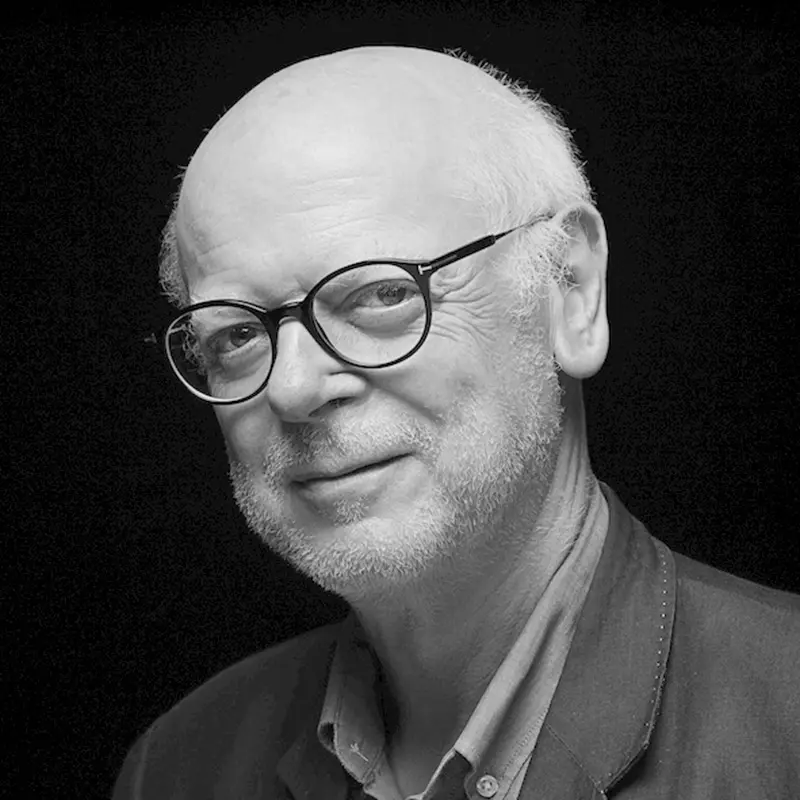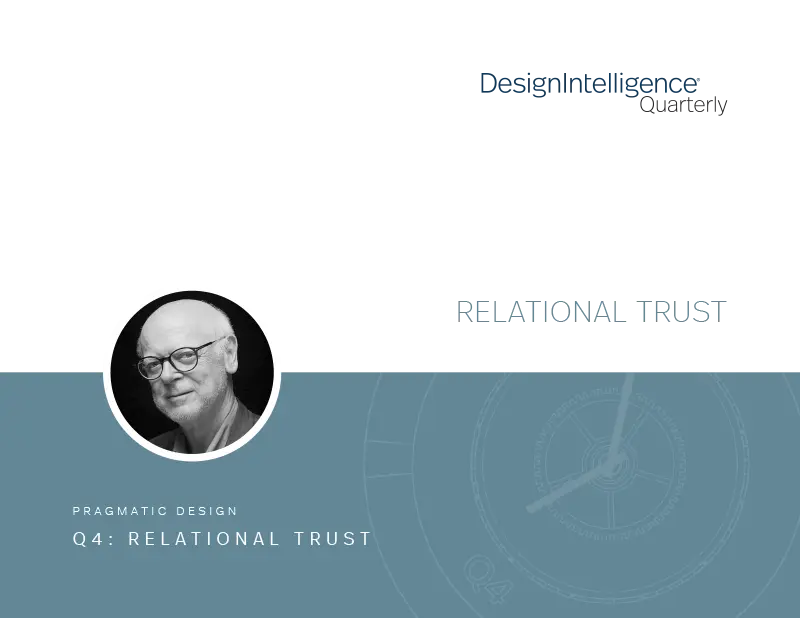Relational Trust
by Paul Hyett
Founder of Vickery Hyett Architects
October 18, 2023
Paul Hyett looks at the “middle ring”
of AEC industry relationships.
“The glue that binds a professional learning community is relational trust.”
So claims Jerome Cranston, dean and professor of Education at Saskatchewan’s University of Regina. A leading researcher in the field of relational trust among and between teachers and the principal within professional learning communities, his findings reveal that:
“Because relational trust appears to be critical to the functioning of a professional learning community, it may be unlikely that substantive school improvement can be achieved without close attention to it.”
I suggest Cranston’s work is highly relevant to everyone involved in the crisis that continues to engulf all sectors of the British construction industry, from those who design our buildings to those who construct them; from those who draft building legislation and codes through to professional indemnity insurers; and from product and component manufacturers to those who test and certify their wares.

That crisis emanates from the horrific fire that engulfed Grenfell Tower some six years ago on the night of 14 June 2017. Whilst Sir Martin Moore-Bick is now drafting his report on the findings of the public inquiry, which was commissioned in the immediate aftermath of the fire by then-Prime Minister Theresa May, Dame Judith Hackitt and Paul Morrell have independently delivered devastating critiques of, respectively, the U.K.’s system of building regulations and our product information protocols.
The impact of Dame Judith’s report, “Building a Safer Future,” has been profound: It is no overstatement to suggest that the new Building Safety Act, which came into force in early 2023, is almost entirely built on her recommendations. And for all those, particularly in the U.K. and U.S., who have in recent years advocated, presided over or simply welcomed the deregulation of their respective construction industries, it is a sobering thought that the consequences of the Grenfell Tower tragedy have been, seemingly overnight, to shift the U.K.’s status from having one of the least to one of the most regulated construction industries in Europe.
Morrell’s work will, I suspect, prove to be equally important. Authorized in April 2021, his report, “Testing for the Future,” was finally published by Government on 23 April 2023 — suspiciously, a good 18 months after its completion. An obvious complement to Hackitt’s focus on building regulations and fire safety in terms of statutory controls and design, this second report has investigated the territories of product testing, certification and representation through trade literature — another world of astonishing mystery and confusion.
So, whilst Hackitt has laid bare the confused complexity and ambiguity of a regulatory process, which she described as “not fit for purpose,” Morrell, in lifting the lid on a Pandora’s box of misrepresentation and deception in testing and certification, has exposed a world of process and protocols that is obviously completely unfit for purpose as well. He has also drawn attention to the extraordinarily fragmented nature of the British construction industry, which the following image — listing just some of the members and associate members of the Construction Industry Council (CIC) — illustrates only too well:
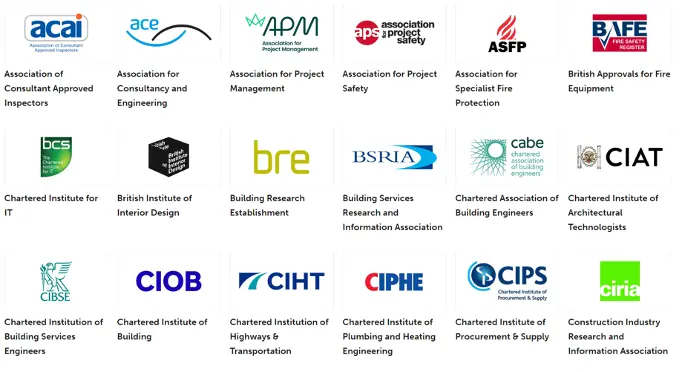
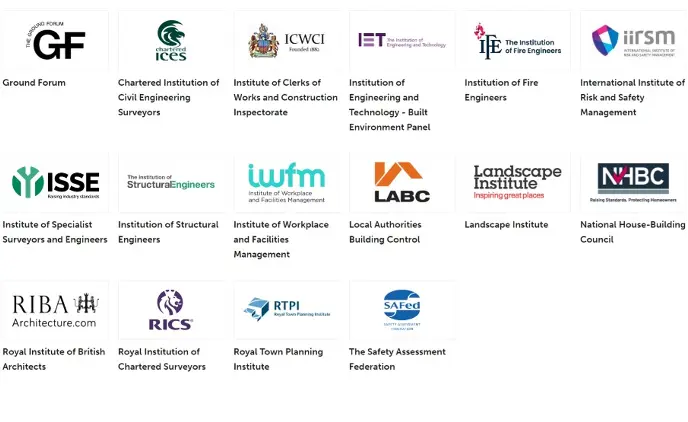
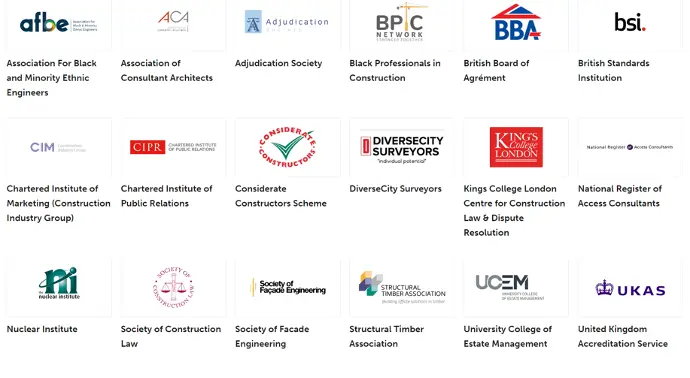
Concentric Circles
British construction is represented by over 500 institutes, guilds and confederations. Together, they now face a monumental challenge in assisting their industry to regain any semblance of public trust. Nothing short of inspirational and dedicated leadership will recover that confidence, and doing so will surely take an enormity of effort and a considerable length of time, but start we must, and we must start somewhere.
Which is why I am so interested in lessons that might be learned from the educational community and the research of Professor Cranston. In a section of his report under the heading “Trust and Professional Learning Communities,” he quotes Crow, Hausman and Scribner who, within their 2002 publication “Reshaping the Role of the School Principal,” offered a model of professional learning communities that uses three concentric circles.
They describe the innermost circle as representing the teacher/pupil relationships, whilst the outermost circle represents the teaching faculty and the community at large. Against those contexts, the middle ring represents relationships amongst the faculty within the school. It is this middle ring and its mediation between the outside world and the inner workings of the classroom that became the focus of Cranston’s study.
And it is this territory that offers profound lessons for our disgraced construction industry as it embarks on its mission to “clean up its act” and regain trust.

A useful analogy is to take the innermost circle as representing the relationships between corporate leaderships within businesses (all businesses across the construction industry) and the teams they employ, especially those beginning their careers. Against that, the outer ring would represent the community at large: the public who will live, play, learn, be healed, work and trade within and otherwise use the buildings we design and make together. Then, critically, the middle ring represents relationships between those many professional institutes, guilds and trade bodies, registration boards and associations and all the other discrete organisations that comprise our industry.
It is within this middle sector that so much has gone wrong. This is the area in which, in the interest of the wider community and those we lead in our effort to serve it, we should be creating the widest possible matrix of learned communities whose interrelationships are based on trust, knowledge sharing and mutual support.
But here we fail, for our construction industry continues along a trajectory of mistrust, suspicion, deception and exploitation. Instead of seeking conditions conducive to success (for example, investment in research, adequate design time, the development of mock-ups and prototypes and sharing information on failures), our industry continues in its irresponsible path of “packaging” risks and passing them downstream — and of setting contract conditions and obligations that grimly anticipate, and all too often precipitate, failure rather than laying grounds for success.

I will never forget a director of a major Chinese company disparagingly telling me, in contrast, that their industry embraces risk and collectively solves construction problems.
When I began my architectural education back in the early ‘70s, we were advised by our first-year tutor in no uncertain terms that, irrespective of any formal or contractual duties towards a “paying client,” we have a higher duty to serve the public interest. This was a shot across the bows of those who might fall under the spell of the dastardly property developer, but the message was clear. The importance of those words and that sentiment cannot be overstated today. At a nanosecond to midnight the architectural profession, and the industry of which it is inextricably a part, face the ecological crisis that now makes an urgent demand for eco-responsible and sustainable design.
In trying to identify where and why things have gone so wrong, I would point to the introduction of Design-and-Build (D+B) contracting and the 1984 Building Act. The former was introduced as a way of getting ever earlier construction starts in the face of raging inflation, which, in the construction industry, peaked at 28% in the later 1970s. But whilst early starts against abbreviated and “just in time” production information lessened inflation’s impact, it heightened clients’ exposure to claims, so “novation” of design teams to so called D+B contractors was introduced as a way of ensuring reductions to client risk. Such procurement methods have since become the U.K.’s norm for almost all construction work of size, albeit at great cost to design and construction quality.

In parallel, the 1984 Building Act substantially undermined what had been an effective building control system by challenging the authority and autonomy of the building inspectors and district surveyors through the introduction of a parallel, privatised arrangement of “approved inspectors.” Thereafter, the state’s municipal building control system, once respected around the globe, was progressively strangled through underfunding and the damage of cut-price competition to a point where, despite the ongoing hard work and determination of many within, it could all too often barely function.
Against that gloomy assessment, it is true that the U.K. continues to produce many examples, year on year, of stunning architecture delivered to the highest standards by outstanding construction teams. But the grim reality is that those achievements are all the more laudable because they are delivered through contractual, procurement and regulatory processes that generate dispute, ambiguity of responsibilities and confusion with unfortunate regularity.
The U.K. construction industry now faces its biggest ever challenge. In its efforts to respond, it would do well to become a learning community in a truly professional sense, perhaps adopting a reworking of Professor Cranston’s mantra, quoted, as follows:
“Relational trust is critical to the functioning of a professional and dedicated construction industry. The substantive improvement so urgently required will be achieved through the securing of robust relational trust between its many constituencies.”
Paul Hyett is the founder of Vickery Hyett Architects, past president of the RIBA and a regular contributor to DesignIntelligence.

